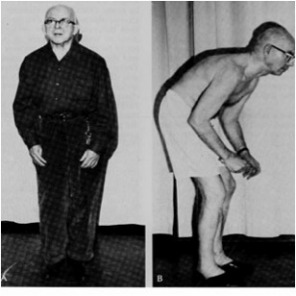This web page was produced as an assignment for Genetics 677, an undergraduate course at UW-Madison.
About Parkinson's Disease

Man with PD. Image is courtesy of healthscape.co.uk (4)
Parkinson's Disease (PD) is a neurodegenerative disorder that affects more than 4 million people worldwide. PD is characterized by tremors, muscle rigidity, and slowed movement, with dementia occuring over time in 20% of patients (1). Other symptoms include impaired balance, difficulty swallowing, slowed speech, and a stooped posture. PD develops when nerve cells in the brain that produce dopamine are degraded (2). Without dopamine, nerve cells lose their ability to transmit messages to parts of the body, which leads to a loss of muscle control commonly seen in patients. The disease is seen mostly in people over the age of 50 years (3). However, the disease has been known to develop in people younger than 20, which is termed as juvenile onset PD. There is no known cure for PD. Current treatment of the disease is intended to control symptoms primarily through medication. Most patients' symptoms are alleviated with medication, however, severe side effects are known to occur (2).
The following video shows animations for describing the symptoms, causes, and hope for those living with PD.
Frequently Asked Questions
1. How do I prevent myself from getting PD?
There is currently no known way to prevent getting PD.
2. Who is more at risk from getting PD?
For unknown reasons, PD occurs more often in men than women (5).
3. What should I do if I show signs of PD?
Symptoms of PD develop slowly over months. If you exhibit signs of PD, you should consult with your doctor for an accurate diagnosis. If you are diagnosed with PD, you should see your health care providers on a regular basis for treatment adjustments.
4. Will I need surgery if I have PD?
Surgery for PD patients is considered after medications fail to alleviate symptoms of PD. Surgical techniques include deep brain stimulation, pallidotomy, and neurotransplantation.
There is currently no known way to prevent getting PD.
2. Who is more at risk from getting PD?
For unknown reasons, PD occurs more often in men than women (5).
3. What should I do if I show signs of PD?
Symptoms of PD develop slowly over months. If you exhibit signs of PD, you should consult with your doctor for an accurate diagnosis. If you are diagnosed with PD, you should see your health care providers on a regular basis for treatment adjustments.
4. Will I need surgery if I have PD?
Surgery for PD patients is considered after medications fail to alleviate symptoms of PD. Surgical techniques include deep brain stimulation, pallidotomy, and neurotransplantation.
The Role of Parkin in Parkinson's Disease

Genomic and domain arrangment of Parkin. Image is courtesy of Kahle et al (8).
Parkin plays a role in the breakdown of unwanted cell proteins by tagging damaged and excess proteins with molecules called ubiquitin. The ubiquitin then directs the unwanted proteins into specialized cell structures known as proteasomes, where the defective proteins are degraded (6). Due to its activity in the ubiquitin-proteasome system, parkin belongs to a protein group called E3 protein-ubiquitin ligases. PARK2 mutations usually lead to a loss of parkin activity and have been shown to cause autosomal recessive juvenile PD, as well as account for the majority of inherited PD cases (7). The mechanism for how PARK2 mutations cause PD is still unclear. However, the loss of parkin activity probably disturbs the ubiquitin-proteasome system, which allows unwanted proteins to accumulate and disrupt cell activities such as the supply and release of dopamine (6). The loss of parkin in the brain could lead to the impairment or death of nerve cells, including the ones that produce dopamine. The figure to the right is of the parkin gene, also known as PARK2, which is one of the largest genes in humans.
References
1. Genetics Home Reference.Retreived January 28, 2010, from http://ghr.nlm.nih.gov/condition=parkinsondisease
2. Medline Plus. Retreived January 28, 2010 http://www.nlm.nih.gov/medlineplus/ency/article/000755.htm.
3. Gene Reviews. Retreived January 28, 2010 http://www.ncbi.nlm.nih.gov/bookshelf/br.fcgi?book=gene&part=parkinson-overview.
4. PD Patient [Photograph]. Retreived January 28, 2010 from http://www.healthscape.co.uk/.../nakamura01_slide02
5. WebMD. Retreived February 9, 2010 from http://www.webmd.com/parkinsons-disease/guide/parkinsons-disease-topic-overview?page=2
6. Genetics Home Reference. Retreived January 28, 2010, from http://ghr.nlm.nih.gov/gene=park2
7. Fishman, P., Oyler, G. (2002). Significance of the parkin gene and protein in understanding Parkinson’s disease. Current Neurology and Neuroscience Reports.2(4), 296-302. doi: 10.1007/s11910-002-0004-7
8. From Kahle, P., Haass, C. (2004). How does parkin ligate ubiquitin to Parkinson's disease? EMBO Reports, 5(7), 681-685. doi: 10.1038/sj.embor.7400188
9."Understanding Parkinson's Disease" video. Retreived Februay 6, 2010 from http://www.youtube.com/watch?v=q458IgW-lLk.
2. Medline Plus. Retreived January 28, 2010 http://www.nlm.nih.gov/medlineplus/ency/article/000755.htm.
3. Gene Reviews. Retreived January 28, 2010 http://www.ncbi.nlm.nih.gov/bookshelf/br.fcgi?book=gene&part=parkinson-overview.
4. PD Patient [Photograph]. Retreived January 28, 2010 from http://www.healthscape.co.uk/.../nakamura01_slide02
5. WebMD. Retreived February 9, 2010 from http://www.webmd.com/parkinsons-disease/guide/parkinsons-disease-topic-overview?page=2
6. Genetics Home Reference. Retreived January 28, 2010, from http://ghr.nlm.nih.gov/gene=park2
7. Fishman, P., Oyler, G. (2002). Significance of the parkin gene and protein in understanding Parkinson’s disease. Current Neurology and Neuroscience Reports.2(4), 296-302. doi: 10.1007/s11910-002-0004-7
8. From Kahle, P., Haass, C. (2004). How does parkin ligate ubiquitin to Parkinson's disease? EMBO Reports, 5(7), 681-685. doi: 10.1038/sj.embor.7400188
9."Understanding Parkinson's Disease" video. Retreived Februay 6, 2010 from http://www.youtube.com/watch?v=q458IgW-lLk.
